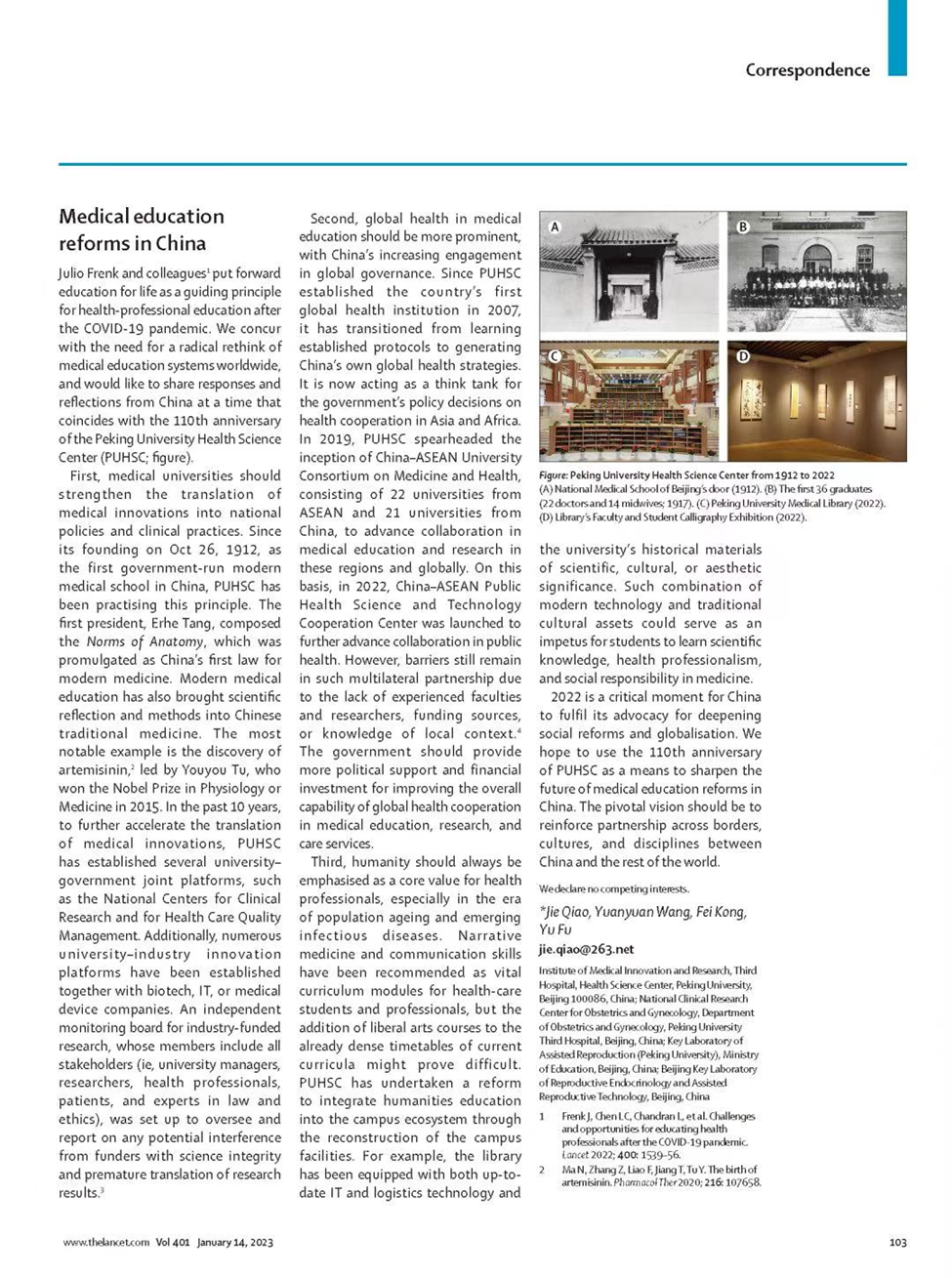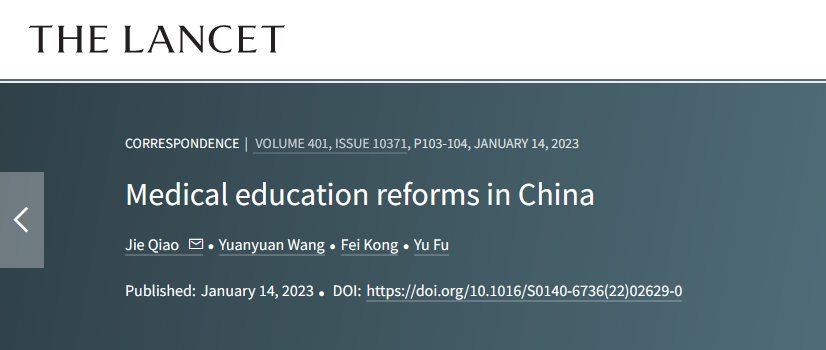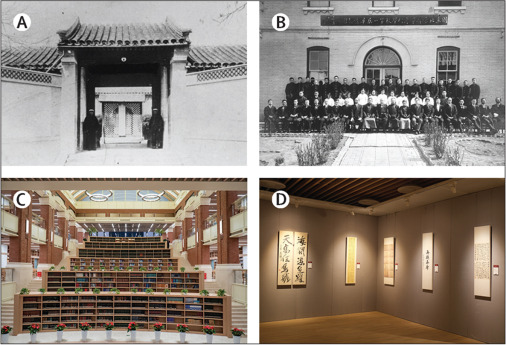Qiao Jie publishes article in The Lancet on China's medical education reforms
Jan 31, 2023
Screenshot: The Lancet
Peking University, January 31, 2023: Recently, Academician Qiao Jie, PKU executive vice president, president of PKU Health Science Center (PUHSC), and president of the PKU Third Hospital, published a correspondence article in The Lancet, a prestigious medical journal, entitled “Medical Education Reforms in China.” Qiao and her team at Peking University concur with the need for a radical rethink of medical education systems worldwide, and share responses and reflections from China at a time that coincides with the 110th anniversary of the PUHSC.
Figure: Peking University Health Science Center from 1912 to 2022
A) National Medical School of Beijing's door (1912). (B) The first 36 graduates (22 doctors and 14 midwives; 1917). (C) Peking University Medical Library (2022). (D) Library's Faculty and Student Calligraphy Exhibition (2022).
In the opening of the article, Qiao pointed out that medical universities should strengthen the translation of medical innovations into national policies and clinical practices. The article highlighted that, since its founding on Oct 26, 1912, as the first government-run modern medical school in China, PKUHSC has been practicing this principle. The first president, Tang Erhe, composed the Norms of Anatomy, which was promulgated as China's first law for modern medicine. Modern medical education has also brought scientific reflection and methods into Chinese traditional medicine, Qiao noted.
“The most notable example is the discovery of artemisinin, led by Tu Youyou, who won the Nobel Prize in Physiology or Medicine in 2015. In the past 10 years, to further accelerate the translation of medical innovations, PKUHSC has established several university–government joint platforms, such as the National Centers for Clinical Research and for Health Care Quality Management,” she wrote. Additionally, numerous university–industry innovation platforms have been established together with biotech, IT, or medical device companies. An independent monitoring board for industry-funded research, whose members include all stakeholders (i.e., university managers, researchers, health professionals, patients, and experts in law and ethics), was set up to oversee and report on any potential interference from funders with science integrity and premature translation of research results.
The second part of the article sheds light on the global context of China’s medical education. Global health in medical education, Qiao put it, should be more prominent, with China's increasing engagement in global governance. “Since PKUHSC established the country's first global health institution in 2007, it has transitioned from learning established protocols to generating China's own global health strategies. It is now acting as a think tank for the government's policy decisions on health cooperation in Asia and Africa,” she wrote.
In 2019, PKUHSC spearheaded the inception of China–ASEAN University Consortium on Medicine and Health, consisting of 22 universities from ASEAN and 21 universities from China, to advance collaboration in medical education and research in these regions and globally. On this basis, in 2022, China–ASEAN Public Health Science and Technology Cooperation Center was launched to further advance collaboration in public health. However, barriers still remain in such multilateral partnership due to the lack of experienced faculties and researchers, funding sources, or knowledge of local context. “The government should provide more political support and financial investment for improving the overall capability of global health cooperation in medical education, research, and care services,” she added.

In her article, Qiao also reviewed the philosophy of humanity in China’s medical education, with PUHSC as an example. She stressed that “humanity should always be emphasized as a core value for health professionals, especially in the era of population ageing and emerging infectious diseases.” Narrative medicine and communication skills have been recommended as vital curriculum modules for health-care students and professionals, but the addition of liberal arts courses to the already dense timetables of current curricula might prove difficult. “PKUHSC has undertaken a reform to integrate humanities education into the campus ecosystem through the reconstruction of the campus facilities,” Qiao highlighted. “For example, the library has been equipped with both up-to-date IT and logistics technology and the university's historical materials of scientific, cultural, or aesthetic significance. Such combination of modern technology and traditional cultural assets could serve as an impetus for students to learn scientific knowledge, health professionalism, and social responsibility in medicine,” she explained.
In the conclusion part, Qiao Jie reviewed the fruitful year of 2022 for the development of PKUHSC. “2022 is a critical moment for China to fulfil its advocacy for deepening social reforms and globalization. The team wishes to use the 110th anniversary of PKUHSC as a means to sharpen the future of medical education reforms in China. The pivotal vision should be to reinforce partnership across borders, cultures, and disciplines between China and the rest of the world,” she wrote.
Written by: Wang Jia'en
Edited by: Meng Bin
Source: PKUHSC


